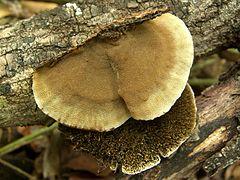| Hexagonia hydnoides |
 |
| Scientific classification |
| Kingdom: | |
| Division: | |
| Class: | |
| Order: | |
| Family: | |
| Genus: | Hexagonia |
| Species: | H. hydnoides |
| Binomial name |
Hexagonia hydnoides
(Sw.) M.Fidalgo |
| Synonyms[1] |
Species synonymy - Boletus fibrosus Hook., (1822)
- Boletus hydnoides Sw., (1806)
- Boletus ursinus Link, (1809)
- Cerrena hydnoides (Sw.) Zmitr., (2001)
- Microporus ursinus (Link) Kuntze, (1898)
- Pogonomyces hydnoides (Sw.) Murrill, (1904)
- Polyporus fibrosus Hook., (1822)
- Polyporus hydnoides (Sw.) Fr., (1821)
- Polyporus ursinus (Link) Fr., (1821)
- Polyporus verrucosohirtus Speg., (1884)
- Polystictus ursinus (Link) Fr., (1886)
- Polystictus verrucosohirtus (Speg.) Speg., (1888)
- Scenidium hydnoides (Sw.) Jülich [as 'hydnoideum'], (1983)
- Trametes hydnoides (Sw.) Fr., (1838)
- Trametes ocellata Berk. & M.A. Curtis, (1868)
- Trametes ursina (Link) Fr., (1849)
- Trametes verrucosohirtus (Speg.) Speg., (1891)
|
Hexagonia hydnoides is a species of fungus in the Polyporaceae family. It is a plant pathogen. This fungus is largely saprophytic, decaying dead wood tissues.[2]
References
This article is copied from an
article on Wikipedia® - the free encyclopedia created and edited by its online user community. The text was not checked or edited by anyone on our staff. Although the vast majority of Wikipedia® encyclopedia articles provide accurate and timely information, please do not assume the accuracy of any particular article. This article is distributed under the terms of
GNU Free Documentation License.
All content on this website, including dictionary, thesaurus, literature, geography, and other reference data is for informational purposes only. This information should not be considered complete, up to date, and is not intended to be used in place of a visit, consultation, or advice of a legal, medical, or any other professional.
